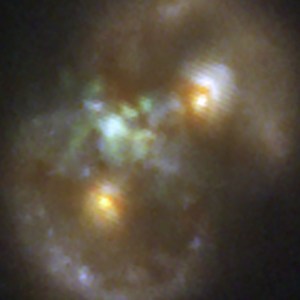Researchers are excited about the latest findings from the James Webb Space Telescope (JWST). They’ve discovered a unique cluster called the Infinity Galaxy. This name, while catchy, actually describes its shape. It has two compact, red nuclei encircled by rings, resembling the infinity symbol.
What’s truly fascinating is what lies within. This cluster seems to have formed when two spiral galaxies collided. In the space between them is a young supermassive black hole, sitting in a vast cloud of gas. Supermassive black holes can be immensely large, often millions of times bigger than our sun. The one in Infinity Galaxy is about a million times the sun’s size.
The discovery of the Infinity Galaxy supports a leading theory in black hole formation known as the direct collapse theory. Typically, black holes develop when massive stars collapse. However, the origin of supermassive black holes is still a puzzle. Some researchers suggest that smaller black holes come together to form larger ones over time. But this doesn’t explain how some supermassive black holes were around shortly after the Big Bang.
The current theory asserts that supermassive black holes can arise directly from the collapse of gas clouds. The Infinity Galaxy might be a key piece of evidence for this idea. Pieter van Dokkum, one of the study’s lead authors, explained, “By analyzing the data from the Infinity Galaxy, we think we’ve pieced together a story of how a direct collapse could occur.” He suggests that when the two galaxies collided, the gas within them was compressed and shocked, potentially leading to the formation of a dense knot that collapsed into a black hole.
While the team can’t definitively confirm this theory yet, their data strongly suggests they are observing a newborn black hole. They aim to continue their investigation to explore other possibilities and help explain the birth of these enigmatic giants.
Recent studies show that discoveries like these can deepen our understanding of the universe. For instance, research from the European Southern Observatory highlights that nearly 90% of galaxies may harbor supermassive black holes. Each finding, such as the one in the Infinity Galaxy, adds another piece to the cosmic puzzle.
As we learn more, our views on black holes continue to shift, making astronomy an ever-evolving field. The insights provided by the JWST are transforming how we understand space, and the Infinity Galaxy is a significant highlight in this ongoing exploration.
Source link
news, webb, jwst, tomorrow, Space, nasa, black hole





















